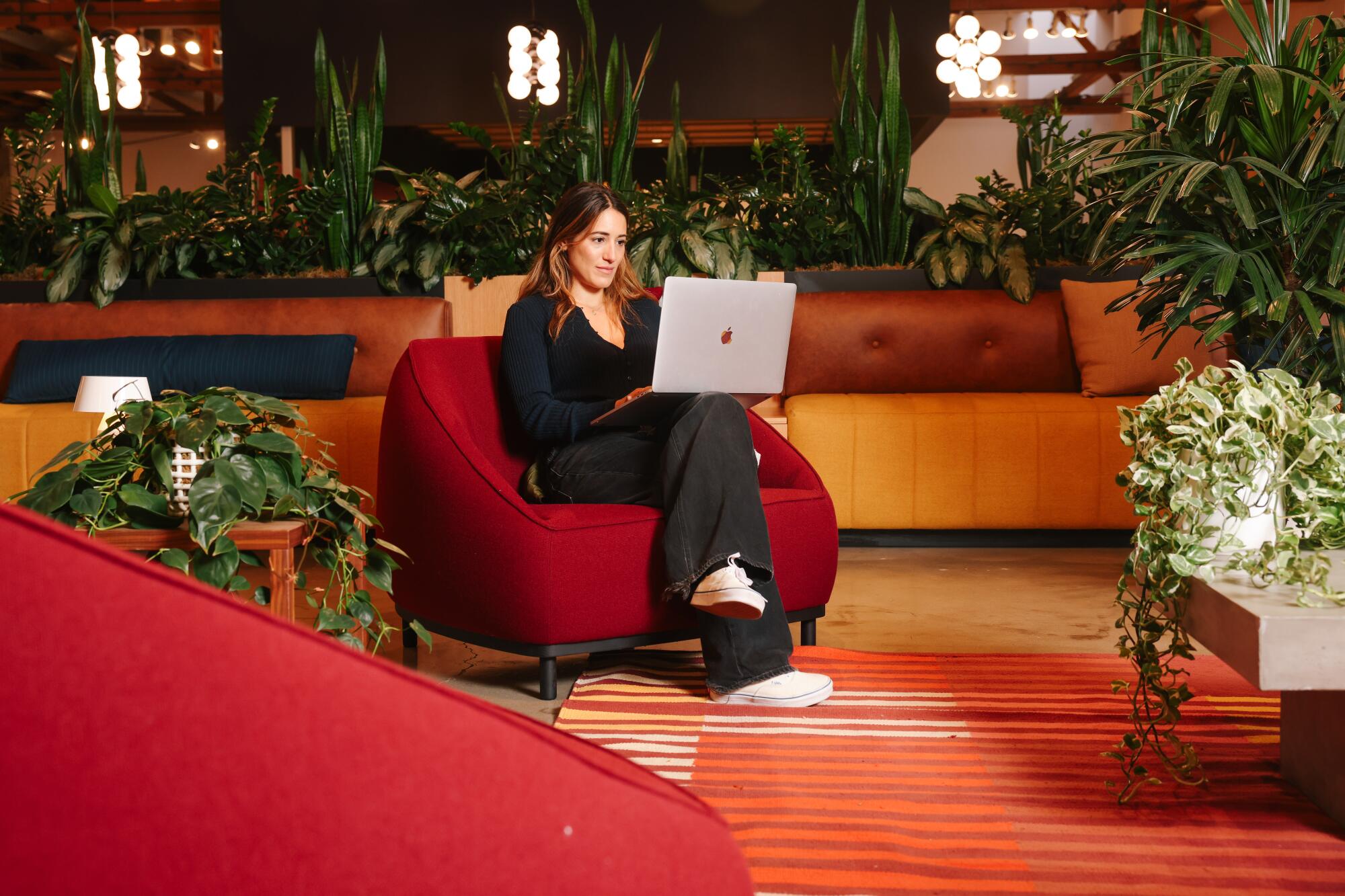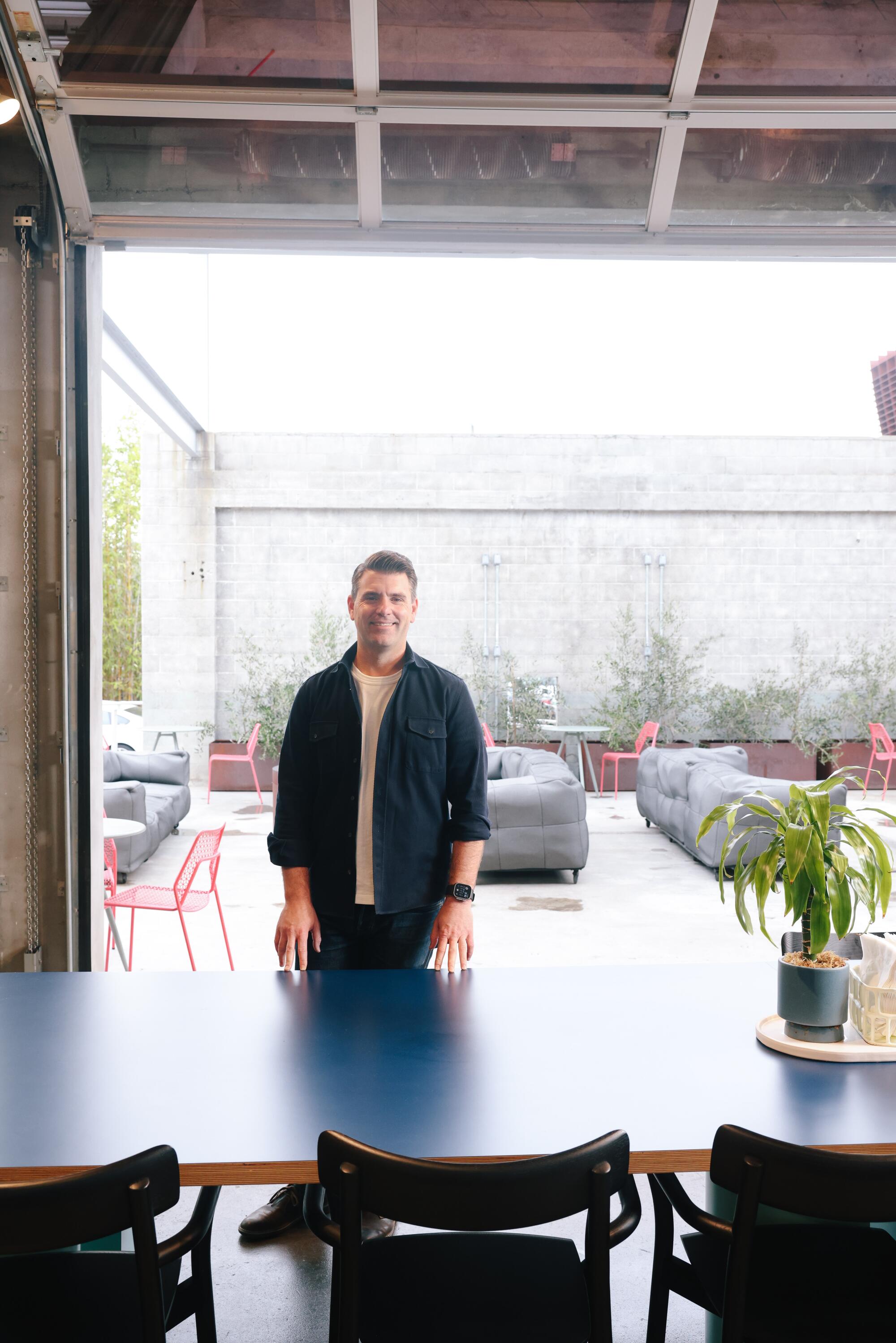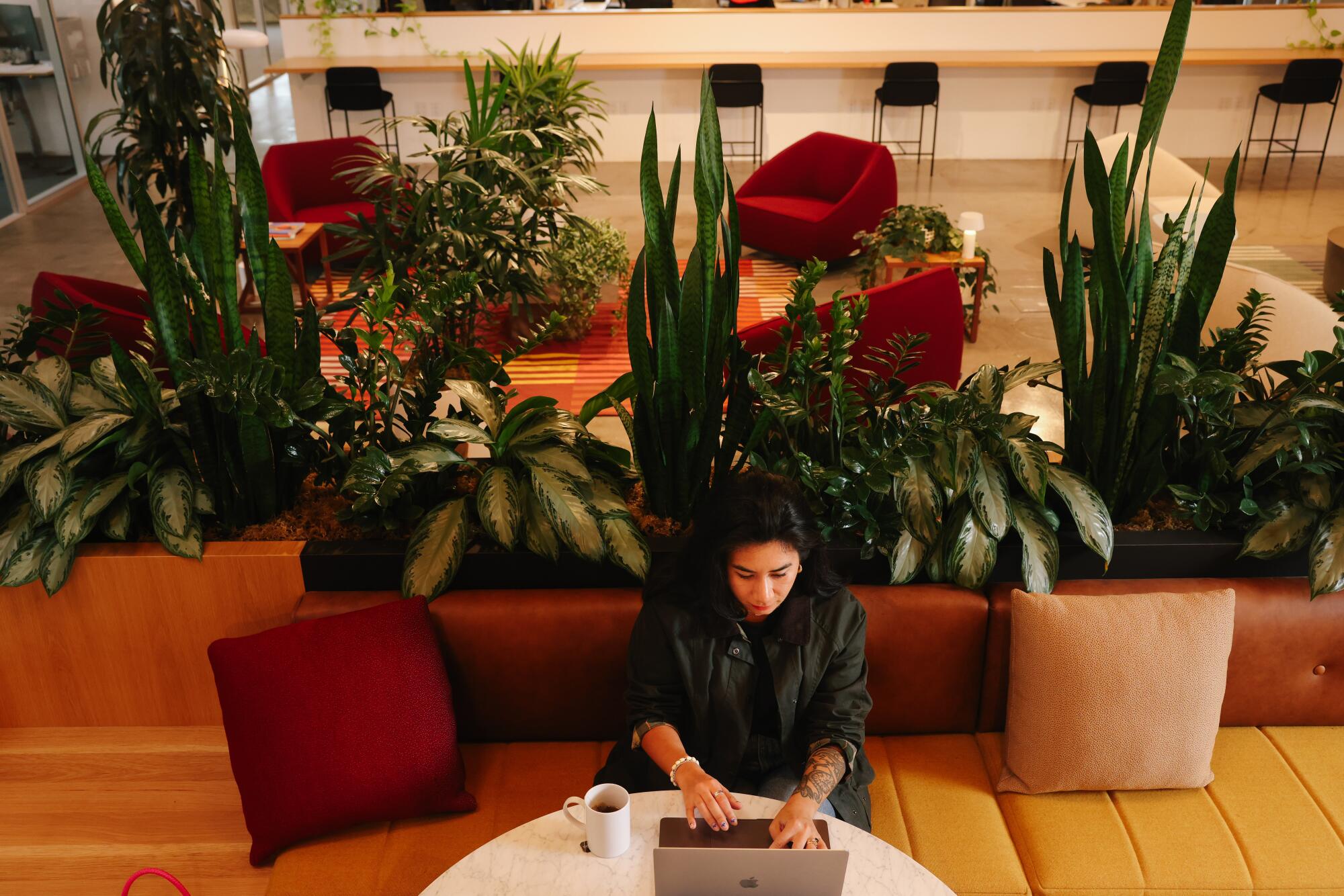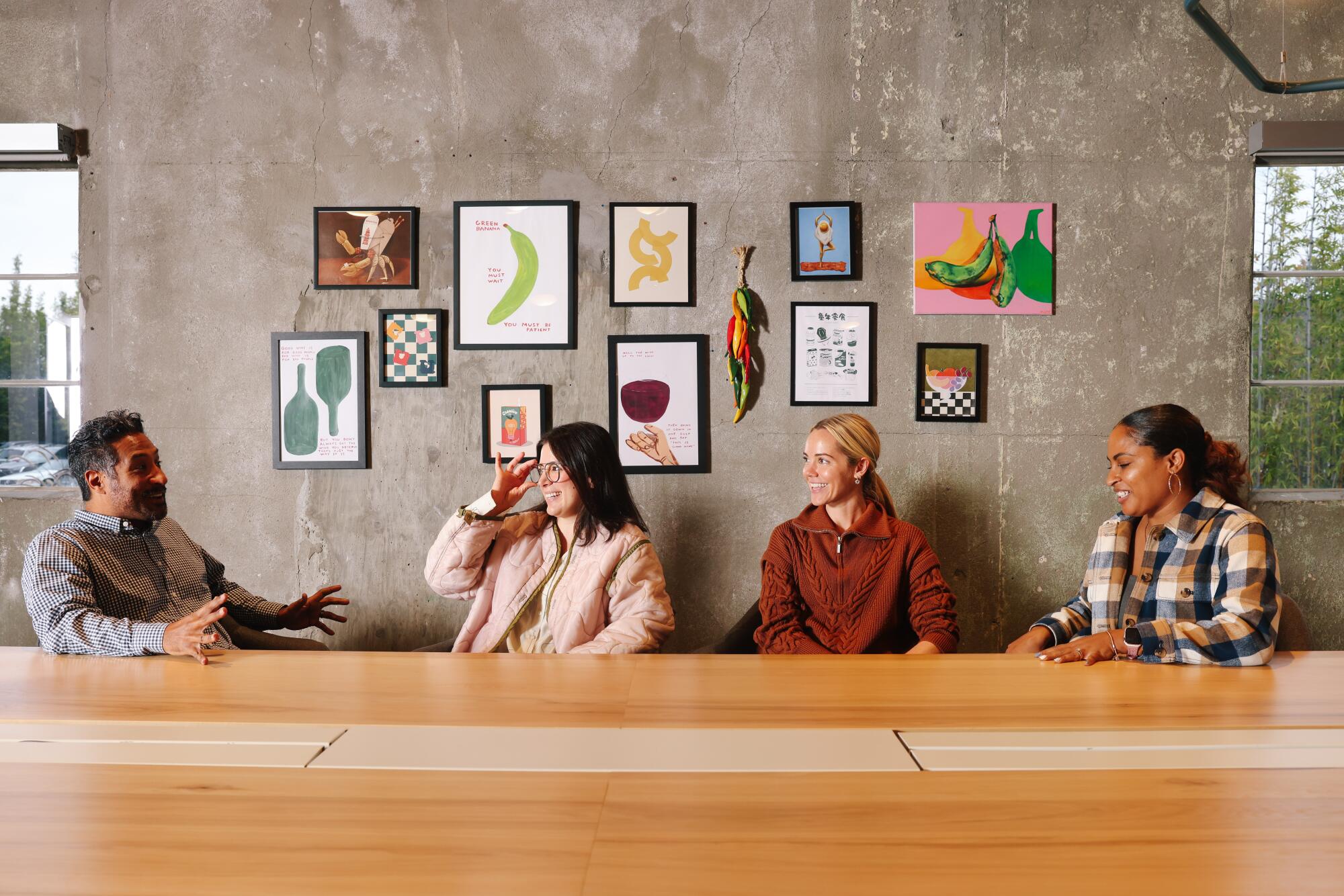
- Share via
In the uneasy tug of war between bosses and workers about how much time should be spent in the office, new evidence reveals that many employees think they should come in more often than they do.
Office workers recently surveyed by an international architecture firm reported that they typically come into the office about half the time, but said they ideally needed to be there two-thirds of a typical workweek for their best productivity. The workers’ attitudes mark a change from the early months after the pandemic, when most said they got more work done at home.
“That has been a surprising evolution,” said Elizabeth Brink, a workplace expert at architecture firm Gensler. “People find they are more productive at the office.”
While some find it easier to focus working at home, others find themselves more easily diverted there. Pets beckon. Children demand attention. Roommates are too loud. “Then there’s all the laundry,” Brink said.
Some employees who say they most need the office are often held back by long commutes, small children who need care or frequent business travel, Gensler found. People working across multiple time zones often find it easier to sync up with counterparts when working from home.
In its international survey of 14,000 workers in 10 industries last year to help its clients make design decisions, Gensler found the biggest gap between what employees do and what they say they should do is among younger generations. Gen Z and millennial workers in their 20s and 30s — more than their older counterparts — value the office as a place to focus on their work, socialize with colleagues, be part of a community and grow professionally.
“I am always learning new things in the office,” one millennial polled by Gensler said. “Whether it’s from my colleagues, my manager, or from training courses, it’s important for my growth and development.”
New research seems to support the idea that working from home leads to less productivity. But are employers measuring remote work results by the right metrics?
Younger workers also commonly want the office to be more than just rows of desks, Brink said, preferring to have options that may include spaces with library-like quiet for individual work and spots that may feel more like a hotel lobby where people can gather to collaborate and bounce ideas around.
Many younger workers also want spaces their older peers wouldn’t have thought to ask for in years past, such as cafes that feel like public coffee bars, fitness centers and meditation or napping areas.

The degree of office style evolution varies widely from company to company, but industries that constantly compete to attract and retain top talent are more inclined to cater to younger workers.
“We need to listen to what their expectations are because we need to rely on those folks and the work that they’re doing,” she said.
Older generations “wouldn’t have thought to ask for” work spaces such as meditation areas that may seem indulgent by previous standards, said Brink, a Gen Xer. “These next generations are not quiet generations,” she said, but their desired work environments may make offices more desirable to their elders too.
With the goal of getting more people back in the office more often, making it a more appealing place to spend time is a key attraction in the carrot-and-stick approach some employers are taking with their workers. Ideally, the upgrades also make people more productive.
Sign up for This Evening's Big Stories
Catch up on the day with the 7 biggest L.A. Times stories in your inbox every weekday evening.
You may occasionally receive promotional content from the Los Angeles Times.
That was one of Chris Webb’s goals when he set up new offices for his company ChowNow, an online food ordering platform that connects customers with nearby restaurants.
When COVID-19 hit, the staff grabbed their laptops and headed home to work. It worked well, for a while, the chief executive said.

“It made a lot more sense right at the beginning of COVID when everyone knew each other on the team because we’d worked together for months, if not many, many years — their personalities and their sense of humor. You understood when someone sent a note online where they became jokey or witty or dry, you knew the personality behind it. “
Personal bonds fell away as months passed and ordinary turnover occurred among the staff, Webb said. The benefits of knowing coworkers in real life were being lost.
“It became apparent to me that we have to get the team back together, we have to be in the office,” he said.
Webb let ChowNow’s lease expire in a conventional office building in Playa Vista and took new space in a former aircraft manufacturing facility in Culver City. There he has created an office designed by Rapt Studio with multiple environments including a large kitchen that can be used by employees as well as for cooking demonstrations and get-togethers among restaurant clients of ChowNow.
Employees at L’Oréal get concierge service, a vegetable garden and other perks as some bosses pull out the stops to get workers back to the office
It has traditional desks and conference rooms but also an area of banquette seating that can be used for personal work, collaboration or dining. Garage-style doors can swing up to provide fresh air and create indoor-outdoor work spaces that include couches, tables and fire pits.
“I think it’s a competitive advantage for attracting employees,” Webb said.
The new digs weren’t an immediate success at bringing employees in, he acknowledged. “There was a little tug of war with some team members.”

Webb set a policy that people had to be in the office a minimum of two days a week or four days a week, depending on their job description. Salespeople, for example, are required to appear more often. The busiest office days are Tuesday through Thursday.
Company data suggest the office is good for business, he said, with internal surveys showing higher job satisfaction among people who labor together.
Most employees of the national company work remotely in other cities and the turnover rate among remote workers is higher than it is among staff who work in the office. Webb thinks that’s because it’s more fulfilling to work together.
“In many ways, the people are the perk” of being in the office, he said.
Subscribers get early access to this story
We’re offering L.A. Times subscribers first access to our best journalism. Thank you for your support.
As Webb found, part of the challenge to achieving a communal vibe is getting a critical mass of people in the office at the same time.
“There is still a disconnect between what is happening and what companies would like to happen,” said Julie Whelan, head of a global team tracking trends among tenants for commercial real estate brokerage CBRE.

People roll into the office an average of 2.8 days a week, CBRE found, but bosses desire to have them show up an average of 3.4 days of the week. Efforts to boost attendance since the pandemic eased haven’t always succeeded, even with the old five-days-in-the-office workweek completely off the table at most companies.
“So now the question that companies are asking is, ‘After three or four years into this, what the heck can I do?’” to persuade people to show up in person more often.
In recent years, many bosses thought the solution was to clearly spell out their expectations for office attendance, but it wasn’t enough to substantially change behavior.
“There was a brief uptick in visitations in some companies that has kind of fallen back out because what was missing from just communicating the expectation is a key piece of the equation — communicating the why.”
Even the best offices will not be utilized any more than is convenient for people’s schedules if they don’t see why it will be of benefit to them. Those benefits must then be delivered, but many companies are falling short on that front.
“That’s where there is probably the biggest disconnect right now,” Whelan said.
There are nuances among companies and industries, but the overarching in-person benefits most employees want are growing interpersonal connections and professional development, she said.
“You need to make sure that when they do come in, they are getting the benefit of those two things.”

Offices that support teamwork, collaboration and other performance objectives are an added boost, she said. “You’re going to have that perfect scenario where your culture, your workplace and your employee experience are all in sync.”
More to Read
Sign up for This Evening's Big Stories
Catch up on the day with the 7 biggest L.A. Times stories in your inbox every weekday evening.
You may occasionally receive promotional content from the Los Angeles Times.

















